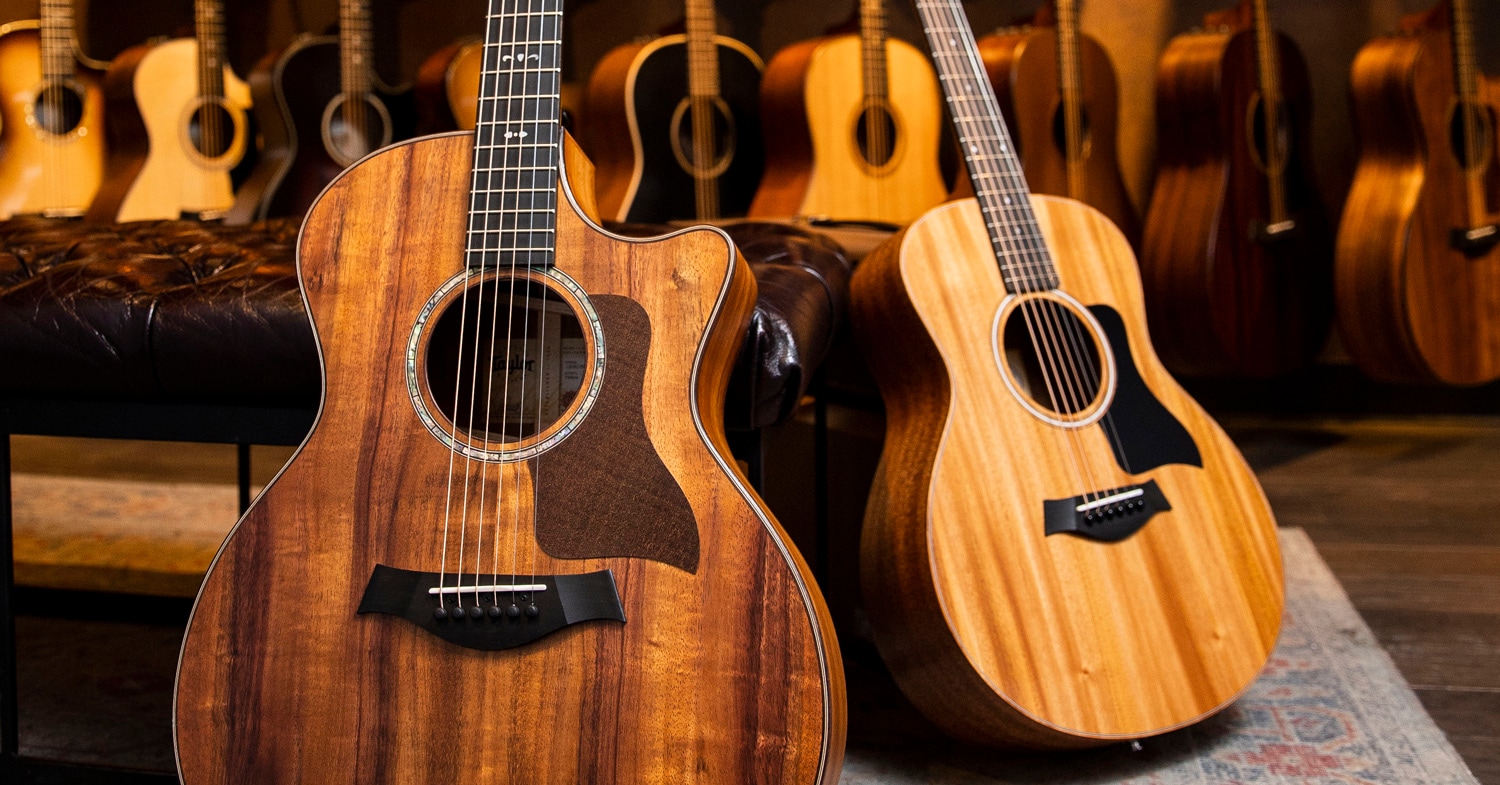In its 50 years of existence, Taylor Guitars has gone from three young men building guitars by hand in a tiny, 1,500 square foot shop to a renowned international manufacturer known for innovation, quality and commitment to sustainability. The list of Taylor players is long and varied, but they have always relied on the sound and feel of their instruments to be at the forefront, eschewing the use of celebrity-studded ad copy. The guitars, like the spirit that founded the company, speaks honestly and harmoniously to the power of music. But how did they get there?
Table of Contents
The History of Taylor Guitars
Taylor Guitars and Innovation
Taylor Today
A Guide to Taylor Series and Model Names
Taylor Series Cheat Sheet
Taylor Body Style Cheat Sheet
Taylor Suffix Cheat Sheet
A Guide to Buying the Right Taylor Guitar
Baby Taylor
Taylor GS Mini
Taylor Grand Theater Models
Taylor Grand Concert Models
Taylor Grand Auditorium Models
Taylor Grand Pacific Models
Taylor Dreadnought Models
Taylor Grand Symphony Models
Taylor Grand Orchestra Models
Taylor 50th Anniversary Models
Taylor Legacy Series Models
Circa 74: An Acoustic Amp Worthy of Taylor Guitars
Taylor's 50 Years of Innovation and Evolution
The History of Taylor Guitars
Bob Taylor was only 18 and freshly out of high school when he started working for a small guitar-building shop called American Dream Musical Instrument Manufacturing (a name we'll come back to) in 1972. American Dream is notable in the history of contemporary luthiery as, over its short four years of life, it was a breeding ground and springboard for a number of builders who went on to become eminent in their own rights, including Greg Deering (Deering Banjos) and Larry Breedlove (Breedlove Guitars), as well as Taylor.
But this is Bob Taylor's story, and it was at American Dream that he met Kurt Listug. In 1974, Taylor and Listug, along with Taylor's childhood friend and fellow employee Steve Schemmer, bought the business from founder Sam Redding and set out as heads of a new company, Westland Music Company. This name was quickly changed to Taylor Guitars because (a) it was easier to fit on a headstock and, (b) "Bob was the real guitar maker," as Listug said in a 2011 interview, and the new company immediately started shipping guitars with the soon-to-be-familiar Taylor headstock.
So, with Taylor sculpting necks and designing instruments, Listug building bodies and going out in the field to sell guitars to dealers, and Schemmer doing the finish work (and, according to Listug, paying a fair number of the bills in the process), the company was born.
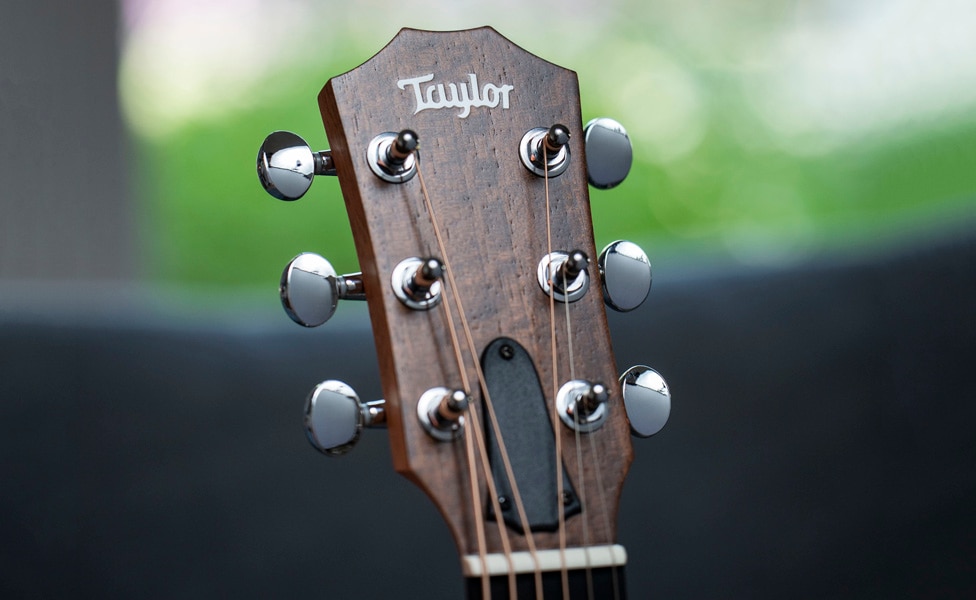
Pictured: Taylor Guitars Headstock
During those early years, Taylor's focus was on producing affordable guitars that were loosely based on the classic Martin-style guitars. But in the small 1,500 square foot shop, Bob Taylor was quietly working on improving playability and refining construction, much of which we'll touch on in the section on Taylor's technological innovations. It took most of a decade of hand-to-mouth existence, with Listug out on the road, pulling into small towns and using the local Yellow Pages to find music stores where he could try and sell a guitar or two, and Taylor working impossible hours building instruments so they would have stock to sell, before players began to discover the advantages of the playability and distinctive tone of Taylor Guitars.
Interestingly, it was electric guitar players who kick-started the growth of Taylor's profile in the mid-1980s, shortly after Schemmer had sold his share of the company to Taylor and Listug. Taylor’s slender, faster necks made them an easier instrument to play if you were more used to electrics, and the brighter tone stood out more in a mix.
In one interview, Bob Taylor recalled going to an acoustic guitar event and noticing that, while the bluegrass flatpickers were largely sticking with the traditional Martins, Gibsons and similar guitars, a majority of the players in the fingerpicking competition, most of whom were also electric players, were playing complex fingerstyle arrangements on Taylor guitars. This, Taylor felt, was further proof that his ideas about acoustic guitar construction were coming into their own.
After Taylor introduced a blue-stained maple/spruce model at the 1984 NAMM show, artists started requesting guitars in colors, which spurred the creation of the Artist Series. A purple Taylor further increased interest in colorful guitars when Prince’s custom 12-string made an appearance in the 1985 “Raspberry Beret” video—though played by Revolution guitarist Wendy Melvoin. Prince did use a purple Taylor Grand Concert 612ce when he performed on MTV Unplugged in 2004.
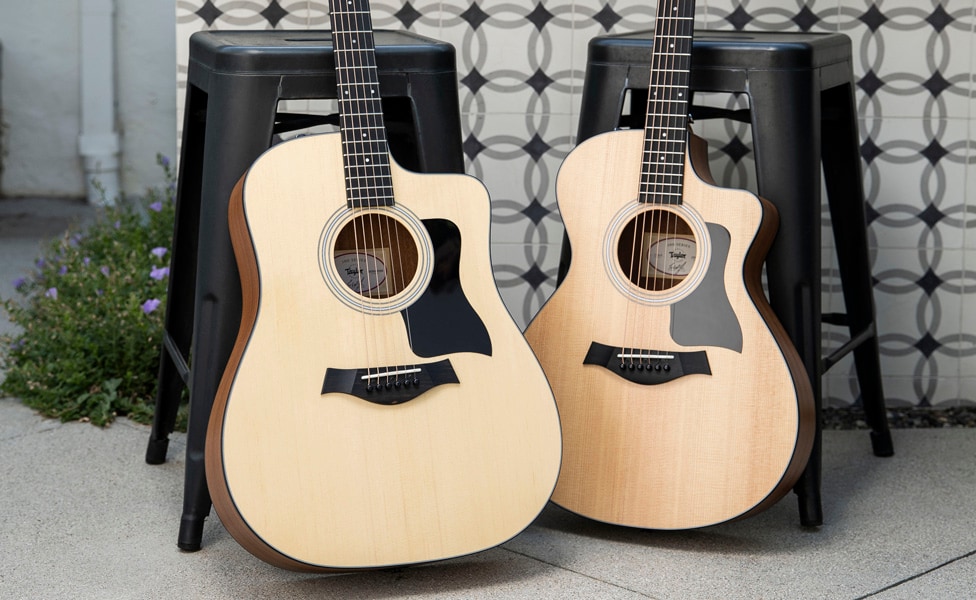
Left: Taylor 110ce Sapele Dreadnought; Right: Taylor 112ce Sapele Grand Concert
“Until Prince came along, I think too many guitarists saw acoustic guitars as a folkie thing,” said Lustug in the book, Taylor Guitars: 30 Years of a New American Classic. “With the colored finishes, we made an acoustic guitar that a hip electric guitarist wouldn’t be embarrassed to play.”
After Taylor Guitars began to gain popularity and wider availability in the mid-1980s and early 1990s, the new models and innovations came thick and fast. Taylor, from the beginning, had maintained different series that were indicative of wood and trim levels, and they began adding new body styles, which we'll cover in more depth below.
In the mid-1990s, Bob Taylor wanted to answer critics who said Taylor made great guitars purely because they had an exceptional inventory of wood. Wanting to put the focus back on guitar making, he crafted the “Pallet Guitar” out of the opposite of exceptional wood—its back and sides fashioned from old, oak shipping pallets and top made from a sliced-up two-by-four. The “lesson” worked so well that a limited run of 25 Pallet Guitars was produced in 2000. Bob Taylor’s exploration of alternate woods also helped shape his interest in environmental stewardship.
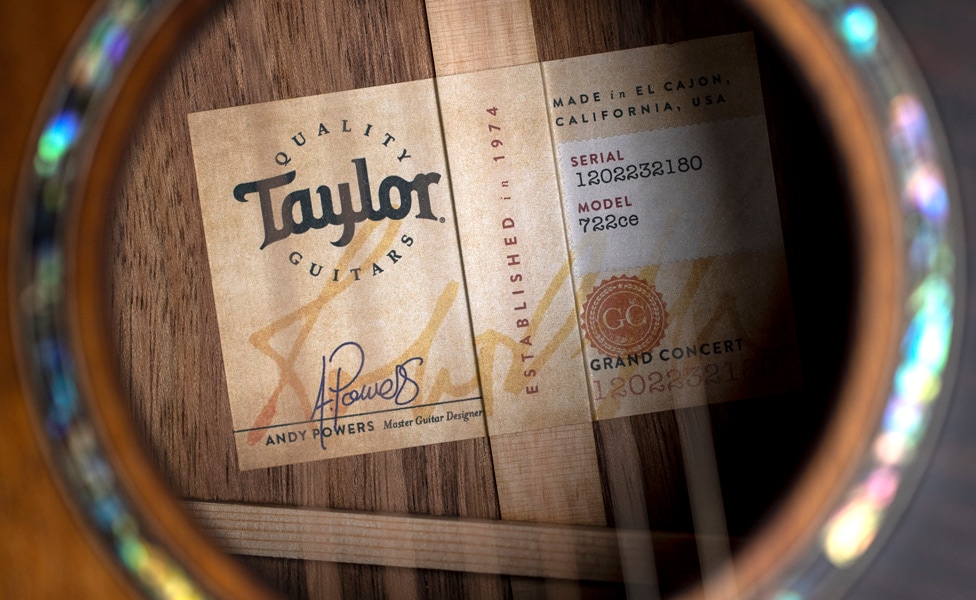
Pictured: Taylor 722ce Koa Grand Concert Natural
A major shift in Taylor Guitars' dynamic occurred initially in 2011, when Bob Taylor brought a young acoustic guitar designer named Andy Powers into the company as Master Guitar Designer. The two had become acquainted when the teenage Powers had met Taylor at a concert and showed him a ukulele he had built. Taylor was impressed, and told the 15-year-old Powers, “If you ever need a job, come look me up.” After assuming his new role, Powers immediately began to develop new ideas and further innovate, earning Taylor and Listug's admiration and respect for his vision and talents. Powers' ability as a designer also allowed Bob Taylor to concentrate more on sustainability issues, including working toward responsible koa harvesting in Hawaii and ensuring that other tropical woods like ebony were being ethically harvested. These issues were becoming increasingly important to guitar builders everywhere, as more and more woods were being restricted by the CITES treaties. In 2014, Taylor was awarded a U.S. State Department Award for Corporate Excellence (ACE), citing, among other things, their development of a sustainable ebony mill in Africa. Back at the factory, which Taylor still likes to refer to as “his shop,” Powers’ star would rise rapidly, but before we talk about how that has affected the Taylor of today, let's take a closer look at a number of the innovations that have come out of Taylor Guitars over the past 50 years.
Taylor Guitars and Innovation
Even before Taylor Guitars became a company, Bob Taylor had been innovating under the umbrella of American Dream Musical Instruments. From his very earliest builds, he had been experimenting with thinner, faster necks that played more easily, chasing the feel of one of the earliest electric guitars he had owned.
Along the way, he found that that type of neck required a different style of attachment than the traditional dovetail neck joint and began the development of a bolt-on neck that would look and feel right for an acoustic guitar. His innovation here involves extending the supported section of the fingerboard from where the neck joins the body (usually the 12th or 14th fret, depending on style) to the 19th fret. This creates a more stable neck and a stronger neck joint.
Because there’s no glue joint, this bolt-on arrangement also makes the occasional readjustment of neck angle—something pretty much all guitars require at some point as they age—much easier and far less time consuming.
Taylor was also one of the earliest adopters of automated manufacturing techniques, going from Bob Taylor designing manufacturing jigs after hours in the early years to bringing in computer-controlled milling as the business grew, wherever it made sense and wouldn't affect quality.
Taylor also developed their unique ES (Expression System) pickups in collaboration with legendary audio engineer Rupert Neve. With a Neve-designed preamp and a pickup system that combined a humbucking induction pickup mounted in the neck with a pair of soundboard-mounted transducers, the current generation ES2 pickups create a far more complex and natural-sounding system than traditional under-saddle acoustic pickup systems.
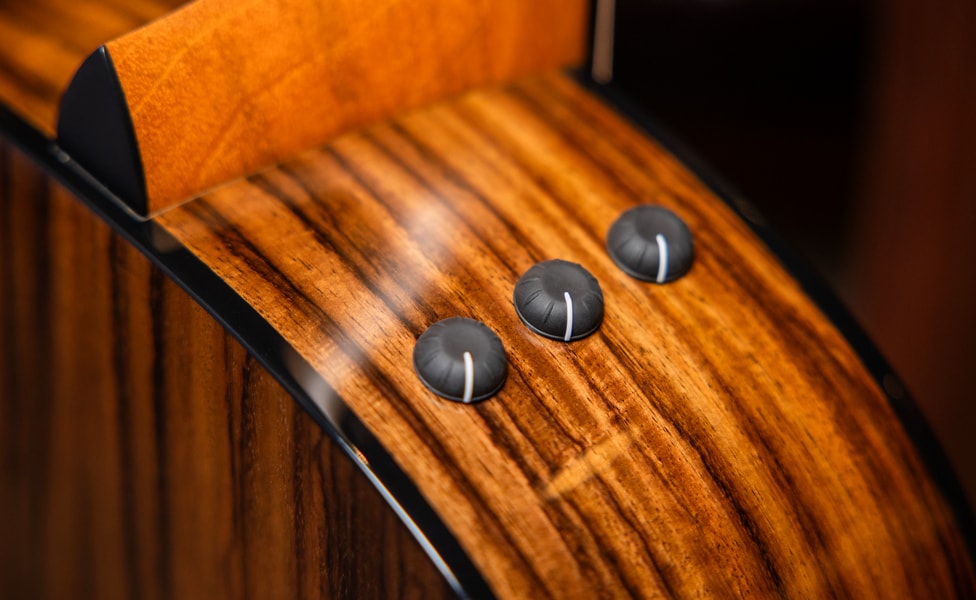
Pictured: Taylor 50th Anniversary GS Mini-E Rosewood Vintage Sunburst
The latest of Taylor Guitars' innovations, V-Class bracing, came from the imagination and skills of Andy Powers. Debuting in 2018, V-Class allows for greater flexibility of a guitar's top without reducing its strength, adding volume and sustain. An additional side effect of freeing the top to vibrate more readily is an increase in the ability of the strings to vibrate in tune with each other, improving the guitar's overall intonation. Since its debut, V-Class bracing has become the standard for all U.S.-made Taylors.
Taylor Today
In 2019, Andy Powers became a third ownership partner, along with Taylor and Listug, but there was a surprise in store. Just two years later, in 2021, citing a desire to keep Taylor Guitars' unique creative culture and family vibe intact, Taylor Guitars transitioned to being a wholly employee-owned company, ensuring all 1,200 of Taylor's employees a share in the company's continued growth and success.
Recently, in a nod to the company's origin, Taylor has created the American Dream Series (see, we told you we'd be coming back to that), a series of builds that hark back to the early guitars that were aimed at providing exceptional value in a more affordable package.
One thing that Taylor's unique corporate culture has enabled over the years is the creation of numerous custom and limited-edition builds of spectacular instruments that range from the use of unique or rare materials to some truly special finished and build touches. These are always in demand and are never available for long. Some recent examples are this "sinker" redwood and Indian rosewood guitar, this stunning torrefied spruce and rosewood instrument and a lovely 214ce DLX Ziricote model with a warm, glowing sunburst finish.
A Guide to Taylor Series and Model Names
From very early on, Taylor has had a wide range of series and body styles in a variety of woods. Individual series have default tonewoods that are used in their construction, though that can vary. When it does, it's called out in the model name. So, each model name can indicate a lot about what features an individual guitar has. Here is a quick decoder key to help you recognize what features and construction go along with each model.
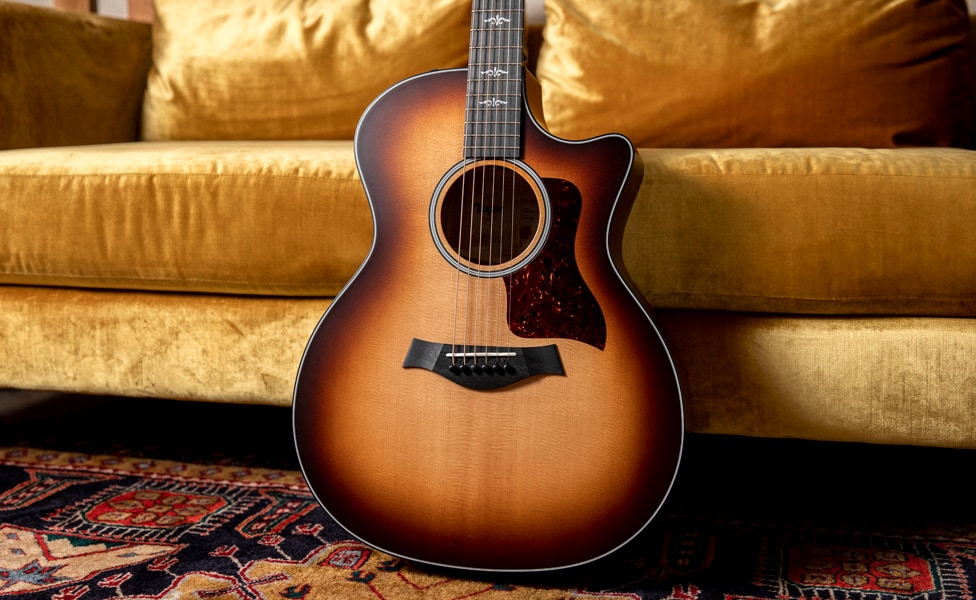
Pictured: Taylor 314ce-K Special Edition Grand Auditorium Shaded Edge Burst
The typical Taylor model name looks something like this: 314ce. The first digit indicates the particular series a guitar is in, in this case a 300 series. The second digit indicates whether it's a softwood (spruce or cedar) or hardwood (mahogany or koa) top. This will be a 1 for softwood or a 2 for hardwood. For 12-strings, it's 5 for softwood and 6 for hardwood. The third digit indicates body style, for which see the table below. Next, a lowercase "c" indicates a cutaway. If there's no "c," there is none. After that is a lowercase "e" to indicate whether there's a pickup system on the guitar. Once again, if it's not there, then it’s a purely acoustic instrument. Sometimes there may be a prefix to indicate some special feature in the instrument, like "K" for a Koa Series or "PS" for Presentation Series. There are also suffixes separated by a hyphen to indicate some variations. "N" says it's a nylon string. If there is an alternate wood to the usual for the series used for the back and sides, it's called here, for example "K" for koa or "M" for mahogany. If there's a special finish, it will be in the suffix (see table below). Speaking of which, here are a few tables to get you oriented.
Taylor Series Cheat Sheet
|
Series |
Back/Sides |
Top Wood |
|
100 |
Layered Sapele |
Torrefied Spruce |
|
200 |
Layered Hawaiian Koa or Walnut |
Torrefied Spruce |
|
200 DLX 200 Plus 300 |
Layered Hawaiian Koa Layered Hawaiian Koa, Rosewood or Maple Sapele or Mahogany |
Hawaiian Koa Torrefied Spruce Sitka Spruce or Mahogany |
|
400 |
Indian Rosewood |
Sitka Spruce |
|
500 |
Urban Ironbark or Mahogany |
Torrefied Sitka Spruce |
|
600 |
Figured Big Leaf Maple |
Torrefied Sitka Spruce or Sitka Spruce |
|
700 |
Hawaiian Koa or Indian Rosewood |
Hawaiian Koa or Torrefied Sitka Spruce |
|
800 |
Indian Rosewood |
Sitka, Adirondack or Lutz Spruce, |
|
900 |
Indian or Honduran Rosewood |
Sinker Redwood or Sitka or Lutz Spruce |
|
Baby |
Layered Walnut, Sapele or Hawaiian Koa |
Torrefied Spruce, Mahogany or Hawaiian Koa |
|
GS Mini |
Layered Sapele, Hawaiian Koa or Rosewood |
Hawaiian Koa, Torrefied Spruce or Mahogany |
|
Koa |
Solid Koa |
Solid Koa |
|
Presentation |
Honduran Rosewood |
Sinker Redwood |
|
American Dream |
Walnut or Sapele |
Spruce or Mahogany |
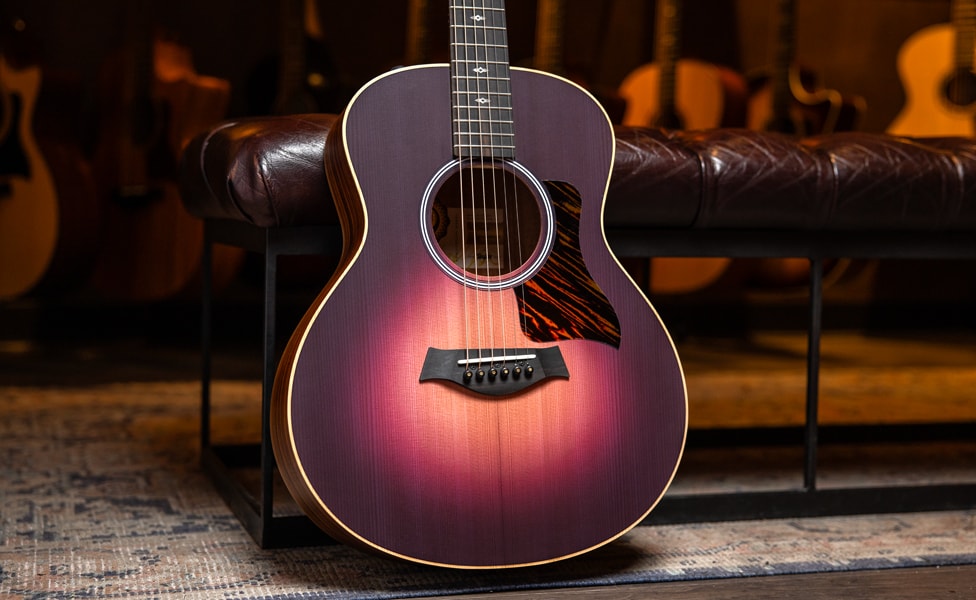
Pictured: Taylor 50th Anniversary GS Mini-E Rosewood Vintage Sunburst
Taylor Body Style Cheat Sheet
|
Body Style |
Number |
|
Grand Theater |
1 |
|
Grand Concert |
2 |
|
Grand Auditorium |
4 |
|
Grand Pacific |
7 |
|
Grand Symphony |
6 |
|
Dreadnought |
0 |
|
Grand Orchestra |
8 |
Taylor Suffix Cheat Sheet
|
Suffix Examples |
Meaning |
|
N |
Nylon String |
|
K |
Koa Body |
|
M |
Mahogany Body |
|
R |
Rosewood Body |
|
SB |
Sunburst Finish |
|
WHB |
Wild Honey Burst Finish |
|
BLK |
Black Finish |
A Guide to Buying the Right Taylor Guitar
While we gave you the numbers that indicate body styles above, in this section, we're going to dig down on what each body style is, and what makes each one unique. From the tiny Baby to the classic large-body dreadnought, we'll also give you examples of current production guitars in each style.
Baby Taylor
Taylor's smallest body size—3/4 dreadnought, to be precise—may look tiny, but it sounds surprisingly big. If you're looking for a guitar that's easy to travel with, a quality starter guitar for young players, have smaller hands or just like smaller guitars, a Baby, like this one may just be your baby. If you like the dreadnought body profile, and want it just a little bit larger, but not quite full-size, don't be a big baby, get a Taylor Big Baby, like this acoustic-electric choice.
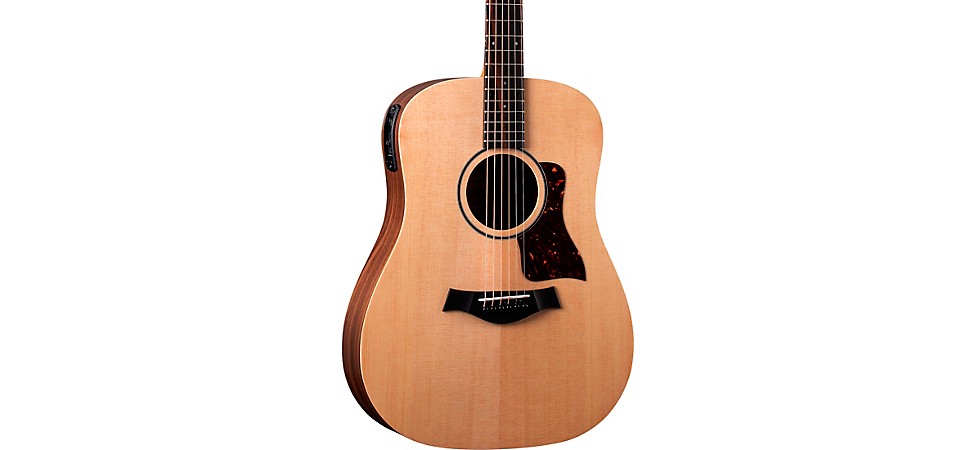
Pictured: Taylor Big Baby Natural
GS Mini
This scaled-down take on Taylor's Grand Symphony body style provides a unique look and big sound in a guitar that's only slightly larger than the Baby. The GS Mini is available in a variety of wood and finish choices, like this mahogany version and this koa acoustic-electric one. In summer 2024, for the baseball-loving guitarists in our midst, Taylor released a limited-edition run of GS Minis that bear the insignia of all 30 MLB teams.
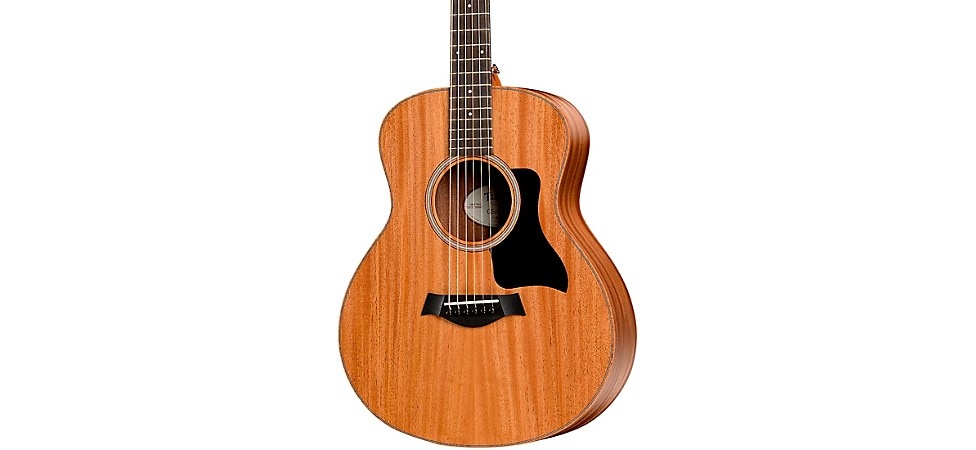
Pictured: Taylor GS Mini Mahogany Natural
Grand Theater
The next step up in body size is the Grand Theater. Sized in between the GS Mini and the Big Baby, this is a beautiful short-scale parlor-size instrument that's voiced to sound bigger than its size would show. It's an incredibly comfortable guitar to play, and great for sensitive fingerstyle playing. These are the first of Taylor's body sizes to be graced with the ES2 pickup system. The Grand Theater is also the first of the body sizes that's available across multiple Taylor series, like this spectacular Koa Series version and this premium 800 Series guitar.
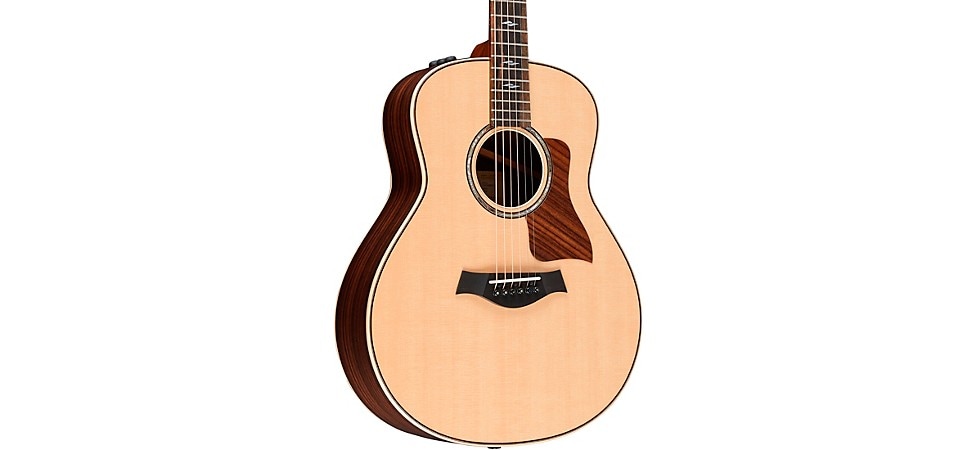
Pictured: Taylor GT 811e Grand Theater Acoustic-Electric Natural
Grand Concert
The Grand Concert is a superlative guitar for fingerstyle playing and a lighter touch, thanks to its articulate response and sensitivity to the player's touch. It's available with the neck joint at the 12th or 14th fret, and also in a 12-string version. This version, from Taylor's Academy line, is a great introduction to Taylor for players on a budget, and this American Dream Series version ups the ante on looks, and moves up from the Academy's ESB pickup system to the Rupert Neve codesigned ES2 system.
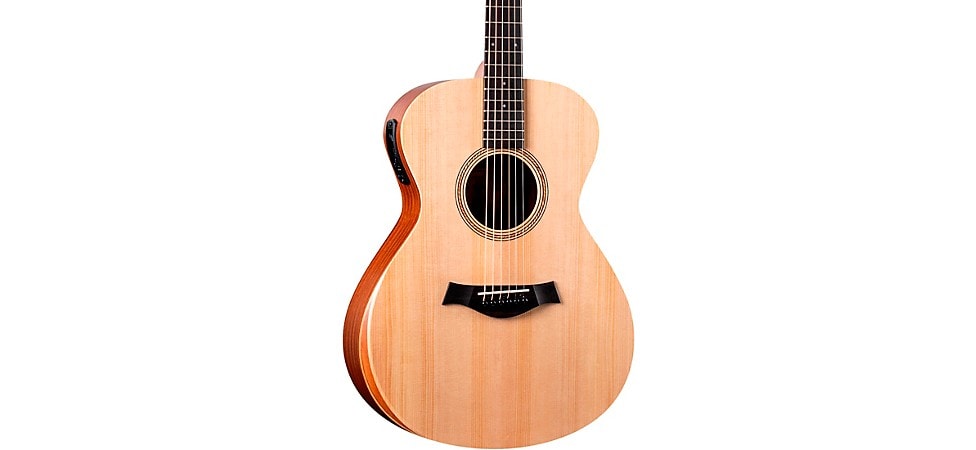
Pictured: Taylor Academy 12e Grand Concert Acoustic-Electric Natural
Grand Auditorium
One of Taylor's original body styles, and their most popular, the Grand Auditorium has developed a reputation as a guitar that can do pretty much anything. Super comfortable to play, and with a well-balanced tonal response and clear, sweet voice—especially with V-Class bracing—it's no wonder that it's a perennial best-seller for Taylor. Check out this Special-Edition version, this well-appointed 800 Series take or this Guitar Center exclusive 114ce in Tobacco Sunburst.
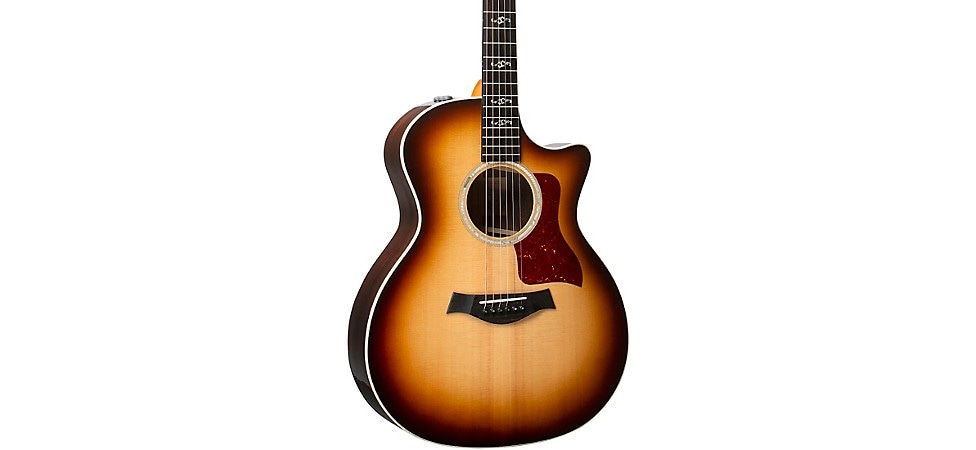
Pictured: Taylor 414ce V-Class Special-Edition Grand Auditorium Acoustic-Electric Shaded Edge Burst
Grand Pacific
The first of two dreadnought body styles from Taylor, the round-shouldered Grand Pacific is another "Swiss Army knife" guitar that's at home in almost any style. With a big, warm voice and a powerful sound, its clarity and punch get heard without overwhelming other instruments. This 400 Series version carries one of Taylor's stylish tobacco sunburst finishes, and this Builder's Edition 700 Series has a stunning Wild Honey Burst on its resonant Lutz spruce top.
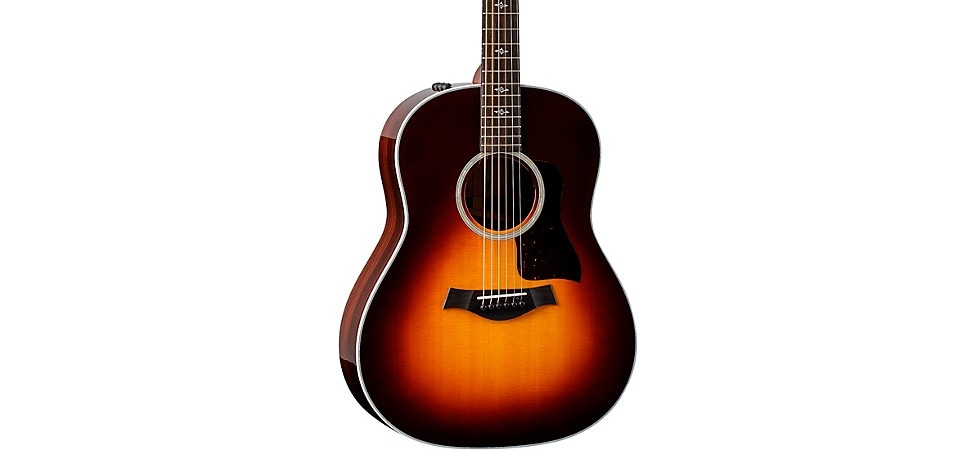
Pictured: Taylor 417e Grand Pacific Acoustic-Electric Tobacco Burst
Dreadnought
Taylor's square-shouldered dreadnought style broadens the guitar's waist to bring out that robust tone dreadnoughts are sought for. Big, beefy lows, punchy mids and a snappy, clear treble are beautifully balanced, making this a great flatpicking guitar, as well as a great choice for powerful strumming. Whether you're going simple, like with this walnut/Sitka spruce 100 Series version, or opting for the brighter edge of the Indian rosewood back and sides of the 200 Series cutaway version, you'll be getting a classic dreadnought that's amazingly easy to play.
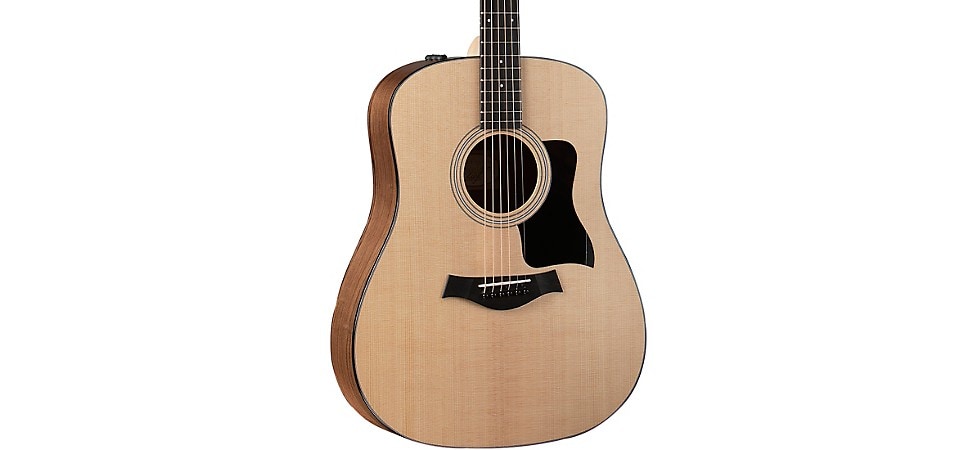
Pictured: Taylor 110e Dreadnought Acoustic-Electric Natural
Grand Symphony
Another of Taylor's forward-thinking original body styles, the Grand Symphony scales up from the Grand Auditorium and adds a unique soundport in the cutaway for a richer, more high-fidelity voice, a more immersive sound and impressive sustain. Whether you choose the Builder's Edition 800 Series or the absolutely stunning Koa Series version, you'll get a room-filling tone that's satisfyingly huge.
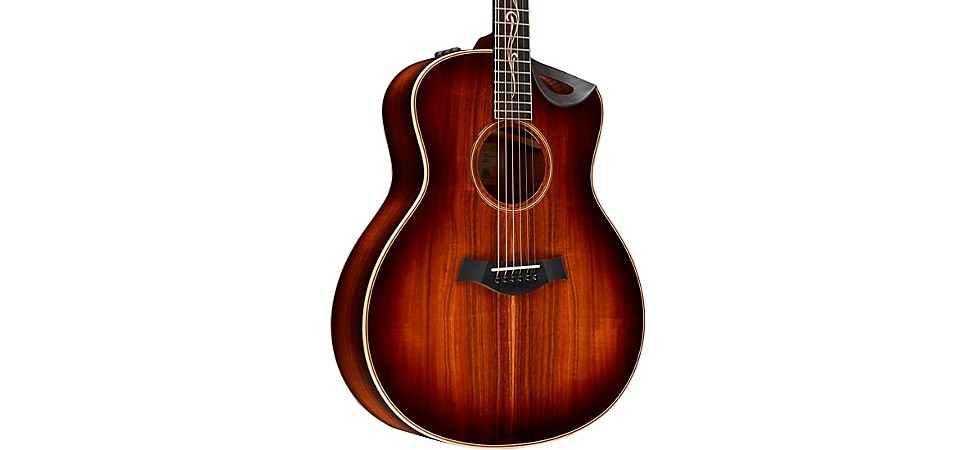
Pictured: Taylor K26ce Grand Symphony Acoustic-Electric Shaded Edge Burst
Grand Orchestra
Taylor's largest, deepest body shape takes the classic jumbo guitar to new territory. Yes, it delivers the powerful sound you expect from a jumbo, with the full-range sound that Taylors are known for, but it also is amazingly responsive to the full dynamics of a player's touch, capable of going from a whisper to a full-throated shout while remaining articulate and clear across the full dynamic range. Whether you like the warmth of traditional rosewood and spruce or the added brightness and punch of solid maple back and sides, a Grand Orchestra will raise your voice above the crowd.
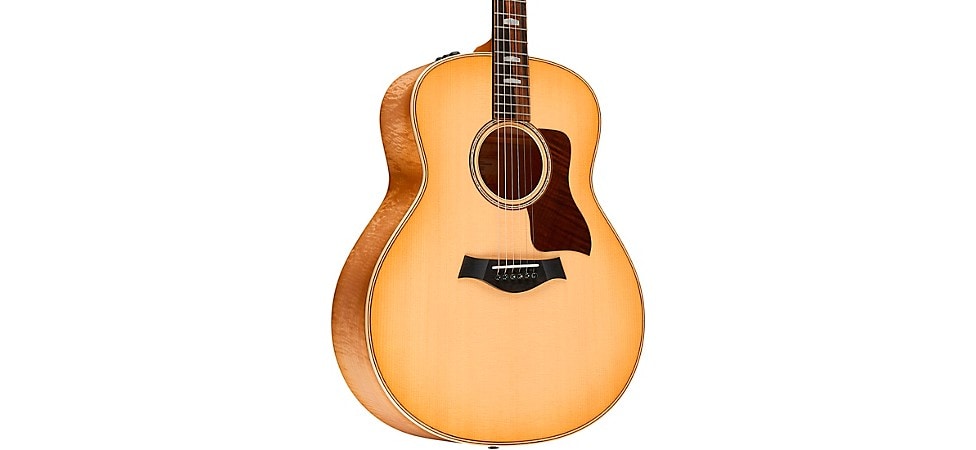
Pictured: Taylor 618e Grand Orchestra Acoustic-Electric Antique Blonde
50th Anniversary Models
To celebrate their 50th Anniversary (1974–2024), Taylor Guitars has created a number of celebratory editions across their line of instruments. Some of these special editions are very limited in number, and none of them will be produced after 2024. Here's a list of what's available so you can join the party, too.
Taylor 50th Anniversary GS Mini-E
This limited-edition of Taylor's scaled-down, 23.5"-scale Grand Symphony body style, the Taylor 50th Anniversary GS Mini-E, features layered rosewood back and sides, and the warm, vintage-like sound of a torrefied spruce top with a custom vintage sunburst finish. A firestripe faux-tortoiseshell pickguard and anniversary diamond-shaped fingerboard inlays add an extra touches of elegance, and the ES2 electronics make sure it sounds as great plugged in as it does purely acoustic. Only 1,974 of these, complete with special 50th Anniversary label, will be available worldwide, so get yours quickly.
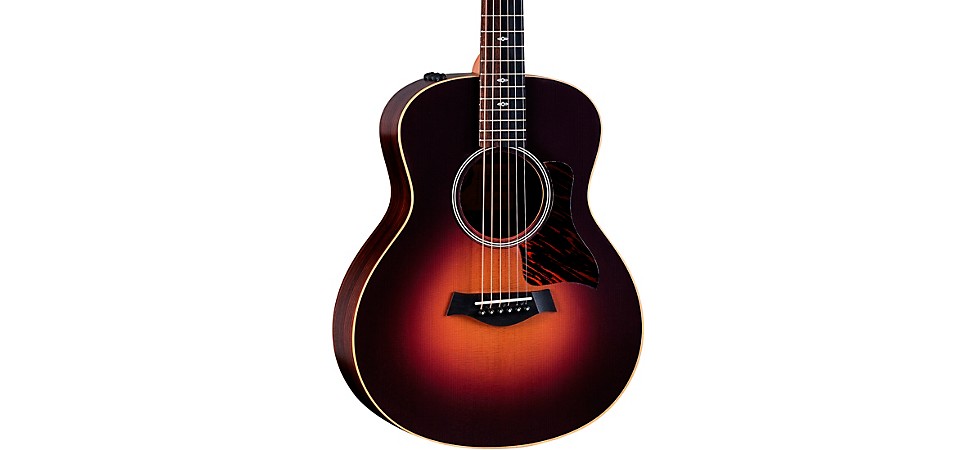
Pictured: Taylor 50th Anniversary GS Mini-E Vintage Sunburst
Taylor 50th Anniversary 217e Plus
Adding a limited-edition guitar to their 200 series, the Taylor 50th Anniversary 217e Plus, a round-shouldered Grand Pacific dreadnought, brings some serious looks and tone to the table with a solid torrefied Sitka spruce top, and layered rosewood back and sides. The comfortable Taylor profile neck is made of tropical mahogany, and the 20-fret fingerboard of genuine West African ebony. This 217e also features the special anniversary trim—diamond-shaped inlays and 50th Anniversary label—plus a custom tobacco sunburst gloss finish, ES2 electronics and Taylor's C-Class bracing.
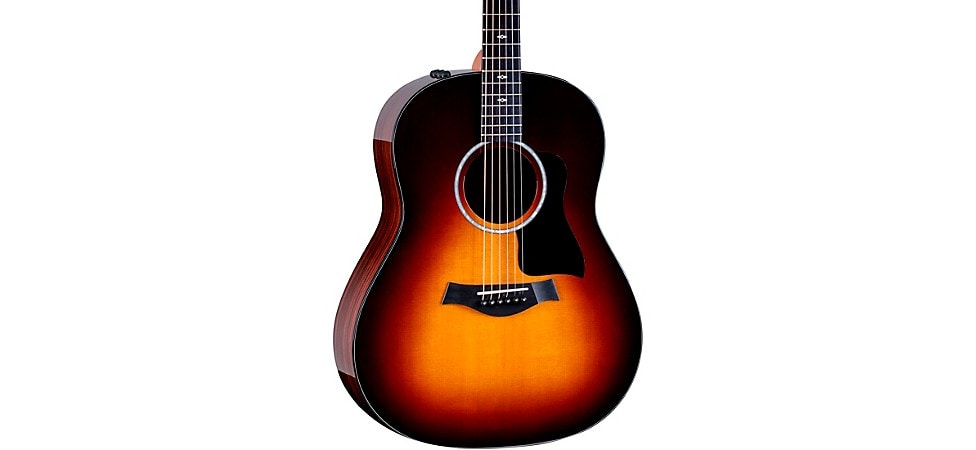
Pictured: Taylor 50th Anniversary 217e Plus Tobacco Sunburst
Taylor 50th Anniversary 314ce
The Taylor 50th Anniversary 314ce offers a torrefied Sitka spruce top, solid sapele back and sides, V-Class bracing, ES2 electronics and a Shaded Edgeburst finish. The Grand Auditorium body style has long been one of Taylor's most popular body styles for its versatility and tone. For the 50th Anniversary version, the aesthetics are upped with anniversary diamond-shaped inlays and a special anniversary back label.
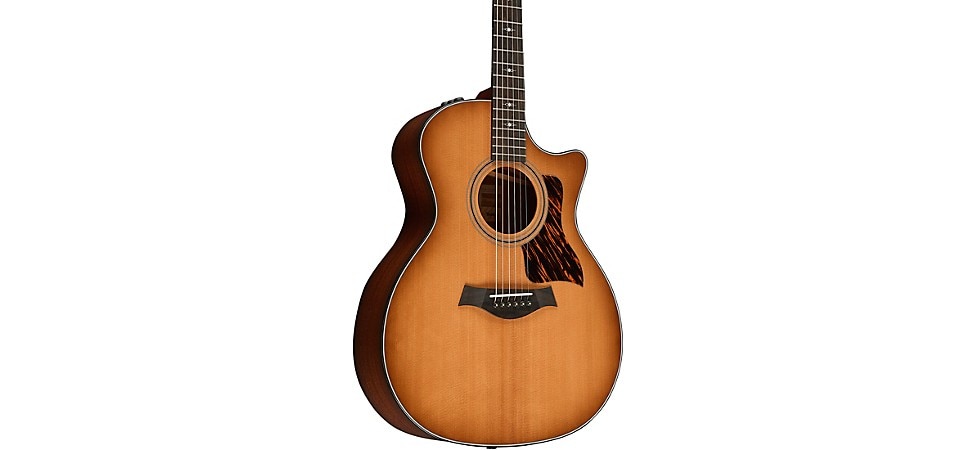
Pictured: Taylor 50th Anniversary 314ce Shaded Edgeburst
Taylor 50th Anniversary Builder's Edition 314ce
Available in either Kona Burst or Natural finishes, the Taylor 50th Anniversary Builder's Edition 314ce Limited Edition features a solid Sitka spruce along with Taylor's Urban Ash back and sides. Urban Ash is harvested from city streets and park shamel (also called evergreen) ash trees that have to be removed because of age or safety concerns, and would normally be chipped or otherwise discarded. These guitars also feature V-Class bracing and the ES2 pickup system, along with a tropical mahogany neck, West African ebony fingerboard and gold hardware. There will be a very limited number of these special guitars built, so if they appeal to you, make sure to get yours early.
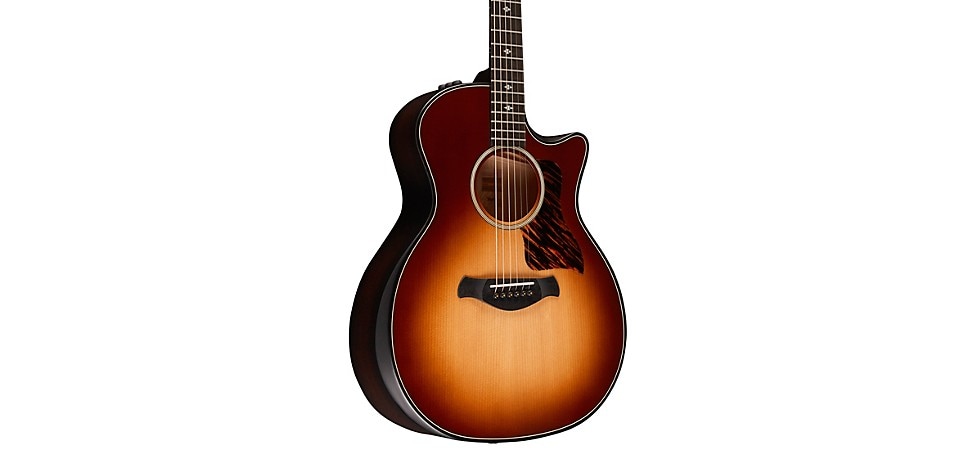
Pictured: Taylor 50th Anniversary 314ce Builder's Edition Kona Burst
Taylor 50th Anniversary Special Edition 414ce
The Taylor 414ce Special Edition 50th Anniversary Grand Auditorium features a sinker redwood top, and East Indian rosewood back and sides, for a rich, full-bodied character. Aesthetic enhancements like a shaded edgeburst finish, Victoria inlay pattern and green abalone rosette make it as visually stunning as it is sonically impressive. Equipped with Taylor’s revolutionary ES2, it yields pristine, amplified tones that are true to the guitar's natural acoustic sound.

Pictured: Taylor 50th Anniversary Special Edition 414ce
Taylor 50th Anniversary Builder's Edition 814ce
Absolutely radiant in its Kona Edgeburst finish, the Taylor 50th Anniversary Builder's Edition 814ce features V-Class bracing and ES2 electronics, but varies the tonewoods with a sinker redwood top, and Indian rosewood back and sides. Lush appointments include a radius armrest, Indian rosewood pickguard, mother-of-pearl inlays and ebony bridge pins. This Guitar Center Exclusive, limited-edition 50th Anniversary Custom Builder's Edition 814ce offers similar appointments in a Shaded Edge Burst finish.
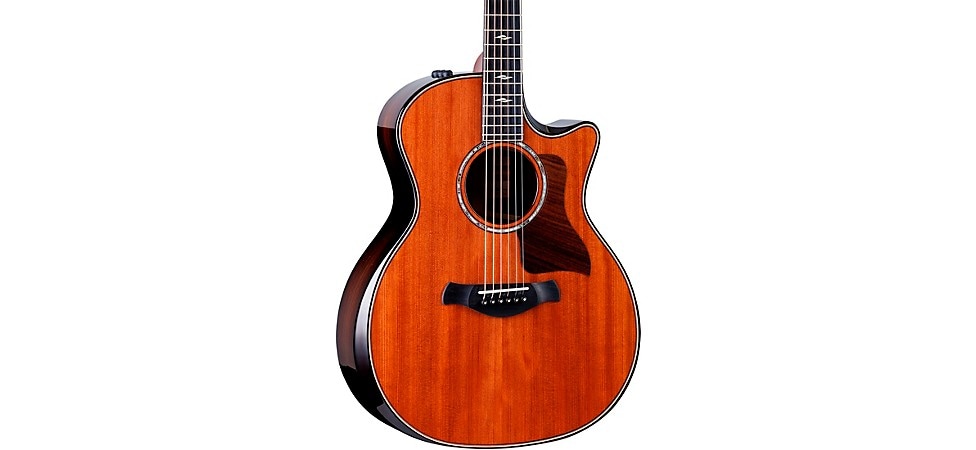
Pictured: Taylor 50th Anniversary 814ce Builder's Edition Kona Edgeburst
Taylor 50th Anniversary AD14ce
The Taylor 50th Anniversary AD14ce sports a lovely tobacco sunburst finish over a solid Sitka spruce top. The V-Class bracing and ES2 electronics are onboard, and other features include a neo-tropical mahogany neck with a West African ebony fingerboard, a smoked eucalyptus bridge and a TUSQ saddle and nut.
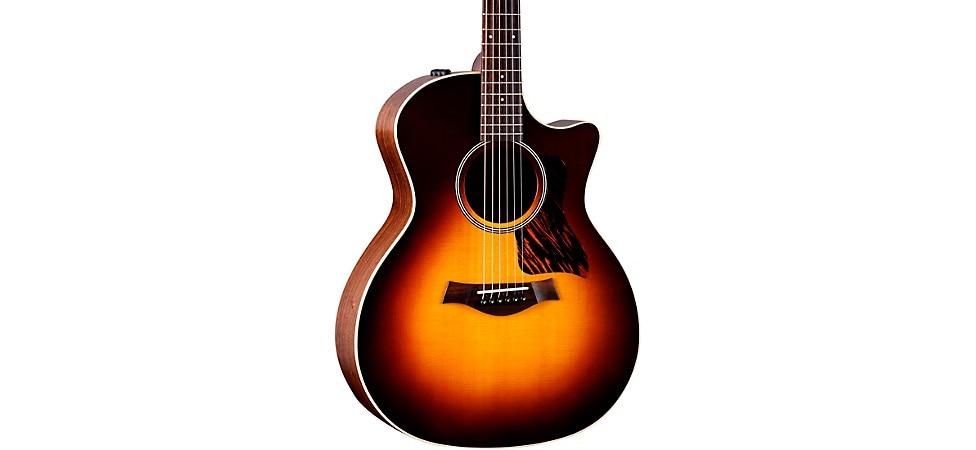
Pictured: Taylor 50th Anniversary AD14ce Tobacco Sunburst
Taylor 50th Anniversary PS14ce LTD
If you’re in the mood to treat yourself to an epic beauty, check out the Taylor 50th Anniversary PS14ce LTD in our Guitar Center Platinum Gear collection. From the Byzantine abalone inlay on the fingerboard to the burgundy-hued Shaded Edgeburst finish, this opulent acoustic demands to be adored.
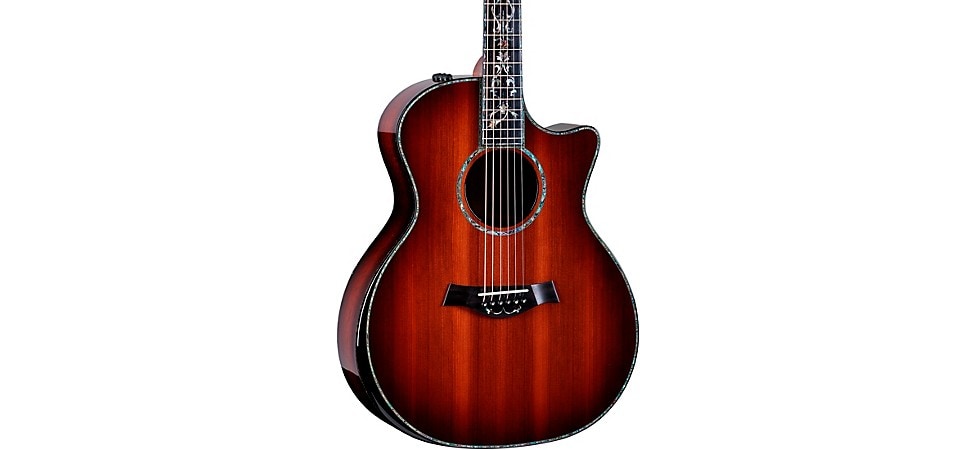
Pictured: Taylor 50th Anniversary PS14ce LTD Shaded Edgeburst
Taylor 50th Anniversary 858e 12-String Limited-Edition
Taylor's 50th Anniversary is a big deal, so it's no surprise that one of their special anniversary builds would be their biggest guitar. This Sitka spruce-topped Grand Orchestra 858e 12-string with Indian rosewood back and sides carries a huge, resonant voice with plenty of 12-string shimmer. As always with Taylor, innovation also pops to the fore with their V-Class bracing and a unique double-mounted string anchoring system that features a shared anchor point for each pair of strings. This anchoring system helps maintain a constant string break over the saddle to create a superb tonal balance. Taylor's ES2 electronics make sure that the jangle is as, well, jangly, whether purely acoustic or amplified. And, as suits this celebratory instrument, the appointments are totally luxurious. A three-ring abalone rosette and mother-of-pearl fingerboard inlays in Taylor's Progressive Diamond pattern combine with the faux tortoiseshell pickguard, ebony bridge pins with distinctive gold dots, and beautifully understated black and white top purfling for a one-of-a-kind look.

Pictured: Taylor 50th Anniversary 858e 12-String
Taylor 50th Anniversary 614ce Limited-Edition
Adorned with a stunning transparent white edge burst finish, the Taylor 50th Anniversary 614ce shines like a musical beacon from any stage. Featuring a big leaf maple Grand Auditorium body and Sitka spruce top, it also speaks with authority, using Taylor's V-Class bracing to adjust the guitar's voice for increased warmth and complexity. With a broad dynamic range and Taylor's signature crisp articulation, this 614ce is well suited to a wide range of playing styles, from nuanced fingerpicking to flat-picked bluegrass speed runs. Taylor's ES2 electronics take you from back porch to big stage without losing a step. Aesthetically, this special Anniversary edition is decked out with faux tortoiseshell binding, green abalone rosette, bound soundhole and matching green abalone fingerboard inlays in Taylor's Wings pattern. We can't think of many better ways to help Taylor celebrate their golden Anniversary.

Pictured: Taylor 50th Anniversary 614ce Limited-Edition
Taylor Legacy Series Models
Taylor’s golden anniversary festivities culminate in a celebratory suite of five guitars, each embodying a mix of old- and new-school design elements. While Taylor has always put innovation first—rarely looking to the past and consistently launching cutting-edge models to acknowledge important historical milestones—the Legacy collection is the first series to reflect on seminal guitars that helped establish the brand. Still, these special instruments aren’t pure reissues, but reimagined versions of classics from Taylor’s lineup, consisting of the 810e, 815e, 855e 12-string, 514ce and 714ce. The first 100 editions of each model are signed by founders Bob Taylor and Kurt Listug.
Taylor 810e Legacy Dreadnought Acoustic-Electric
The flagship 810 dreadnought is one of the first guitars Bob Taylor built, and he recently revealed the original as being his all-time favorite instrument. Inspired by that same guitar, the Taylor 810e Legacy acoustic-electric dreadnought features clean, elegant appointments based on the earliest 800 Series instruments. Its Sitka spruce top, rosewood back and sides, mahogany neck and ebony fretboard are bound in white plastic, while the soundhole incorporates a three-ring rosette with green abalone. You’ll also find Taylor’s older X-bracing pattern inside the 810e Legacy, though the neck leverages their patented modern profile for enhanced playability and easy micro adjustments over time. You can also take the studio or stage with LR Baggs Element VTC electronics, making the Taylor 810e Legacy acoustic-electric a gorgeous premium instrument for serious strummers.

Pictured: Taylor 810e Legacy Dreadnought Acoustic-Electric Guitar
Taylor 815e Legacy Jumbo Acoustic-Electric
The Taylor 815e Legacy Jumbo acoustic-electric has a lot in common with the 810e above, albeit with a different, more prominent body shape. Solid Sitka spruce and Indian rosewood, together, form the Jumbo’s powerful body, tonally offering ample low-end power, an articulate midrange and sparkling highs. You’ll also recognize an ebony fretboard and mahogany neck, carved to the same contemporary Taylor Standard profile for smooth, comfortable chording and lead playing—all amplified by the LR Baggs Element VTC system. The 815e Legacy Jumbo additionally features an old-school, moustache-style bridge for a touch of vintage Taylor flair.

Pictured: Taylor 815e Legacy Jumbo Acoustic-Electric Guitar
Taylor 855e Legacy Jumbo 12-String Acoustic-Electric
Players who prefer the full-bodied timbre of a 12-string will enjoy the Taylor 855e Legacy Jumbo acoustic-electric. As a Legacy Series 800 model, this guitar utilizes the same tonewood recipe found in the others, delivering robust projection, balanced tonality and a harmonious voice suited to soulful strums and mellifluous melodies. Special appointments include mother-of-pearl diamond inlays, a moustache bridge and the X-bracing pattern originally found in earlier Taylor acoustics. The Taylor 855e Legacy Jumbo acoustic-electric also enables convenient live performance and recording amplification with its LR Baggs Element VTC pickup.

Pictured: Taylor 855e Legacy Jumbo 12-String Acoustic-Electric Guitar
Taylor 514ce Legacy Grand Auditorium Acoustic-Electric
The legendary Grand Auditorium shape debuted in 1994 as part of Taylor’s 20th anniversary, and it ultimately cemented the brand’s unique identity and Bob Taylor’s reputation as a skilled innovator. The Taylor 514ce Legacy Grand Auditorium acoustic-electric features a cedar top and mahogany back and sides, producing a versatile, woody sonic signature with a strong focus on fundamental frequencies. Both fingerstylists and flatpickers sing the praises of a cedar/mahogany tonewood combo, making the 514ce Legacy a surefire hit for guitarists in any genre. Paired with the Taylor Standard neck shape and the bold Venetian cutaway, this 514ce is a player’s guitar.

Pictured: Taylor 514ce Legacy Grand Auditorium Acoustic-Electric Guitar
Taylor 714ce Legacy Grand Auditorium Acoustic-Electric
Rounding out the Legacy Series quintet is the Taylor 714ce Grand Auditorium. Like the 514ce, this instrument offers a Western red cedar top, swapping out mahogany with Indian rosewood for its back and sides. The tonal impact is notable—the 714ce’s voice consists of broad, full-spectrum sound with complex overtones and lots of sustain, and its clear, forward midrange is bookended by deep lows and shimmering, bell-like highs. Overall, the Taylor 714ce Legacy Grand Auditorium is a stunning acoustic-electric—a worthy salute to 50 years of ongoing guitar-making mastery.

Pictured: Taylor 714ce Legacy Grand Auditorium Acoustic-Electric Guitar
Circa 74: An Acoustic Amp Worthy of Taylor Guitars
The Taylor Guitars Circa 74 AV150-10 acoustic guitar and vocal amplifier, and its included stand are crafted from solid mahogany, evoking a retro-futuristic cabinet you’d find in a mid-century modern showplace. Its ’50s space-age looks aside, the two-channel Circa 74 delivers 150 watts of power through a 10" full-range speaker. One channel includes a combo XLR and 1/4" input, and the other a 1/4" input—perfect for singer-songwriters and instrumental duos—and Bluetooth connectivity lets you play along with backing tracks wirelessly from a mobile device.
Taylor’s 50 Years of Innovation and Evolution
From the start, Taylor Guitars has been one of the builders who've worked hard to advance the state of the art of luthiery. The ideas about what a modern acoustic guitar could be that Bob Taylor started playing with in 1972 have spread across the entire industry. Taylor Guitars' ongoing commitment to finding new and sustainable building practices, applying technology where it does the most good—while remaining committed to the vision of great-sounding acoustic guitars that deliver unprecedented playability—ultimately drove three teenagers to take their American Dream and make it a reality.




